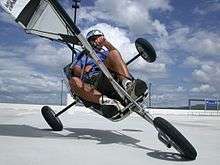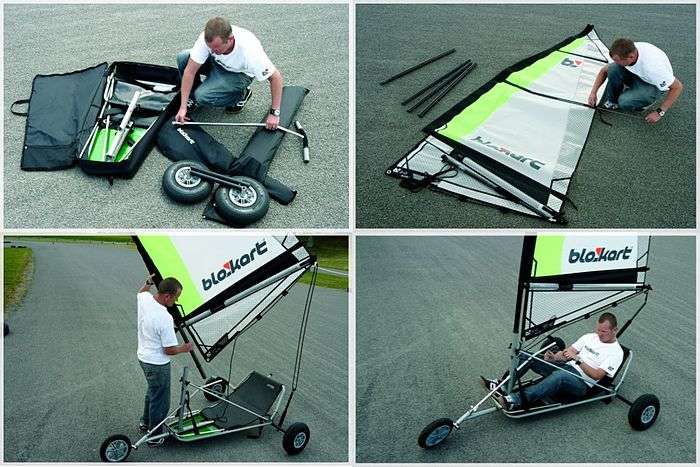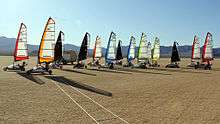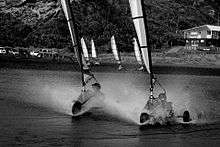Blokart
The Blokart is a popular one-design class of small compact land yacht, manufactured by the New Zealand-based company Blokart International Ltd.[1]

They can be quickly disassembled and packed into a carry-bag giving them a high degree of portability and are designed to be particularly easy to learn to sail. They are used for leisure sailing on beaches in many parts of the world - but Blokart racing is also developing as a competitive international sport, with organised racing including national championships in several countries and a biennial world championship.
History
The Blokart design was developed in 1998 as a joint venture with Paul Beckett and Ross Dickey, Tauranga NZ.[2][3] The first commercial models in a purpose built factory in Papamoa, NZ in 2000 and since then the fundamental blokart design has remained virtually unchanged. By 2017, the total number of karts produced exceeded 14,000 with almost half the sold in Europe.
The basic model including wheels, mast and sail weighs only 29 kg and can be dismantled in a few minutes without tools, and all parts packed into a carry-case. The high degree of portability allows them to be transported by car, or carried as luggage on a plane.

Unlike many other land yachts, the Blokart is steered using the hands via a centrally mounted bar directly coupled to the front wheel. This, along with its compact size, makes it highly maneuverable, and able to be used in small urban areas such as carparks or tennis courts.
Wheels can be replaced with ice blades to allow the Blokart to sail on ice - with the first Blokart Ice World Championships staged in Lithuania in 2010.
A side-car accessory or "Shadow" can be added to carry a passenger, and Blokarts can be joined head-to-tail together using a "Deuce" bar. Multiple can be joined in this way to create long trains.
Blokarts have four standard sail sizes, 2.0m, 3.0m, 4.0m and 5.5m, with sail size choice being dependent on wind strength and weight of the sailor. Heavier sailors require larger sails, and smaller sails are more efficient in stronger winds.
Speeds of more than 100 km/hr have been attained on land and up to 130 km/hr on ice. The current Blokart land speed record of 125 km/hr (77.7 mph) was set by Scott Young and Dave Lussier at Lake Ivanpah in Eastern California on Wednesday, 11 April 2018.[4] The record was set on the 2nd lap of the final race of the 2018 North Americans when a Haboob (desert wind storm) came across the racing area.
Adventure
In 2007 a group of 11 international adventurers crossed the Gobi Desert on Blokarts in a journey planned by French enthusiast Chrisophe Gombert of France, and Mongol guide and friend Batzorig.
Racing

Although Blokarts meet the qualification standard for mini-yachts under the FISLY regulations, they are generally sailed in separate regattas organised under the IBRA rules. The "one design" standard has helped Blokart racing spread rapidly throughout the world - with national and regional championships now being contested annually in numerous countries including: USA, Australia, NZ, Britain, Spain, Belgium, France, Denmark, Sweden, Germany, Lithuania and the Netherlands.
Blokart World Championships have been held biennially since 2008 as follows;
| Year | Location | Country |
|---|---|---|
| 2008 | Papamoa | New Zealand |
| 2010 | Ostend | Belgium |
| 2012 | Ivanpah | USA |
| 2014 | Perth | Australia |
| 2016 | Ivanpah | USA |
| 2018 | Majorca | Spain |
The 2013 European Championships were held in the UK at Weston Super Mare from September the 20th to 22nd; over 100 Blokarts took part.
Blokart Racing is administered by the International Blokart Racing Association (IBRA) who sanction events and set the international racing rules.[5]
Setup
Racing differs to other land yacht racing - which typically has stationary starts and race across the wind on beaches. It actually has more in common with water based sailing, with 2-3 minute dial-up starts and windward/leeward courses. Racing is held on purpose built tracks, airport runways, parking areas as well as beaches and dry lake beds. Races are between 5 minutes and 8 minutes in duration.
The hand steering allows people with lower-limb disabilities to compete with able-bodied pilots.
Sail selection for racing is dependent on pilot weight and the sailing course. Heavier pilots require larger sails; tighter courses generally require a larger sail - and for straighter and more open courses a smaller sail provides less drag and therefore greater maximum speed.
Classifications
Blokarts are raced in two classes – production and performance. The production class is based on the basic design; while in the performance class additional parts from the manufacturer are allowed such as carbon fibre mast sections and an aerodynamic shell, adjustable downhaul and modification of the sail battens to alter the shape of the sail. New components must sanctioned by IBRA before they can be used in racing.
Depending on number of entries at events, Blokart classes are further broken down into weight divisions determined by the body-weight of the racer. For the Blokart world championships the 4 following divisions have been defined:
- Lightweight Division: Less than 70 kg
- Middleweight: From 70 kg to less than 82.5 kg
- Heavyweight: From 82.5 kg to less than 95 kg
- Super Heavyweight: 95 kg and greater
There is generally no differentiation of racers on the basis of age or gender.
Locations
Blokarting can be done on virtually any open area larger than the size of a tennis court. Beaches provide an ideal venue subject to tides, wind direction and density of people.

Some of the most well used areas for Blokarting are listed below.
New Zealand
- Kiwi Land
- Ninety Mile Beach and Tokerau Beaches, in the far north
- Dargaville, Glinks Gully and Bailey's Beach.
- Ruakaka Beach
- Muriwai, Karioitahi, Orewa and other beaches in Auckland
- Ardmore Airport - home of the Auckland Blokart Club.
- BayStation - a purpose built Blokart track in Mount Maunganui
- Ohakea Airforce Base
- Foxton Beach and the Sanson Track in the Manawatu
- Waitere & Waikanae Beaches near Wellington
- Vortex Wind Karting Track and Rabbit Island near Nelson
- GreenPark Sands (Lake Ellesmere just outside of Christchurch) - a dry lake bed usually available Nov-March
- Pegasus Bay Christchurch - 19k's of beach sailing from the "Spit" to the Waimakariri River & Pines Beach to the Ashley River
- Velocity Karts - a purpose built track in Christchurch
- Wigram Airfield - home of the Canterbury Blokart Club
- Oreti Beach near Invercargill
Australia
- Lake Lefroy, Lake Walyungup and Caron Dam Bitumen (Perenjori) in Western Australia
- Lake Gillies and Kingston SE in South Australia
- Mulambin Beach and Farnborough Beach in Yeppoon. Bucasia Beach and Cape Hillsborough at Mackay in Queensland.
- Wangaratta - HQ for the North East Windsport Club @ -36.179696, 146.461640
- Casey Fields Cranbourne, VIC 3977: GPS Coordinates -38.121525, 145.307615 160 Berwick Cranbourne Road Cranbourne East 3977 - home of Victorian Blokart Club
- Olivers Lake and Beaches in Gippsland, Victoria.
United States
- Ivanpah Lake near Las Vegas
- Red Lake (Arizona – New Mexico)
- New Jersey Beaches - Brigantine, Wildwood ( off season)
- Musselman Honda Circuit Arizona
Europe
- Blokart CPH, Amager Strandpark, Copenhagen, Denmark
- Rømø Island, Denmark
- IJmuiden beach near Amsterdam, Netherlands
- Nida, Lithuania
- Ostend and Zeedijk Beaches in Belgium
- LandSailing BCN, Barcelona, Spain
- Zaragoza, Spain
- Land Sailing Tarifa, Spain
- Son Vent blokart track, Binissalem, Mallorca, Spain
- Villaumbrales Blokart Racing, Palencia, Spain
- Asociación Madrileña Blokart, Villanueva de la Cañada (Madrid), Spain
- Saint Pierre Quiberon (Blokart Center), Saint Malo, France
- La Franqui beach, Berck sur mer (Eole club) France
- blokart - LandSailing Austria - Vienna
United Kingdom
- Map of UK Blokart sailing venues
- Cefn Sidan Beach in Wales
- Weston Super Mare in Somerset
- Finmere Aerodrome, just outside Buckingham
Clubs
Australia:
Queensland:
- South East Queensland Blokart Club
- Central Queensland Blokart Club
- Capricornia Blokart Club http://www.sandyachting.info
New South Wales:
- Hunter Valley Blokart Club
- NSW Blokart Club
Victoria:
- Victorian Blokart Club
- Melbourne Blokart Club
- Wangaratta, Victoria - North East Windsport Club, http://www.newc.com.au/
Western Australia:
- Perth Blokart Club
South Australia:
- South Australian Blokart Club
New Zealand:
- Auckland Blokart Club
- Bay Blokart Club
- Hawkes Bay Blokart Club
- Canterbury Blokart Club
- Capital Blokart Club
- Manuwatu Blokart Club
- Top Of The South (Nelson) Blokart Club
United Kingdom:
United States:
See also
- Ice yachting
- Kite buggying
- Kite landboarding
- Land windsurfing
- Whike sailing cycle
- Wind-powered land vehicle
References
- Blokart Website
- "A Kiwi bloke and his 'blokarting' phenomenon". 31 January 2009. Retrieved 11 January 2019.
- "Bay inventor sails on with gusto". Bay of Plenty Times. 9 June 2010. Retrieved 11 January 2019.
- "Who said sailing was boring?". Scuttlebutt. Retrieved 11 January 2019.
- IBRA Website
External links
| Wikimedia Commons has media related to Land sailing. |
- The BLSA UK governing body for Blokart Sailing and Land Speedsailing
- Carmarthenshire Land Sailing Club (UK) - land sailing club sailing at the Cefn Sidan (Pembrey) and also Pendine beaches
- NALSA (USA) - the North American Land Sailing Association
- SeaBreeze Blokart Forum, "Australian Land Sailing Forum" section for Blokarts.
- New Zealand Blokart Association - Includes the IRBA rule book.
- Blokart Heaven - A purpose built land yacht track in Papamoa New Zealand.
- Blokartersuk.com (UK)
- Class Action Racing US blokart website.
- Blokarten.info (in Dutch) - Dutch information portal for blokarting.
- https://www.facebook.com/groups/t.i.shredders/